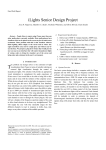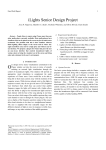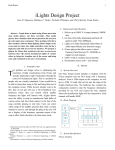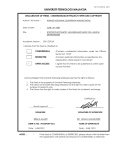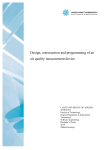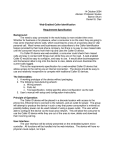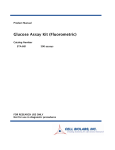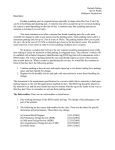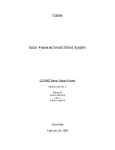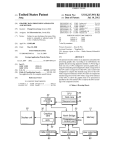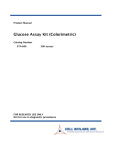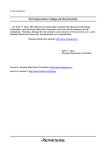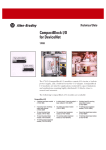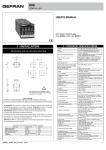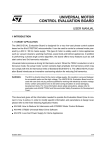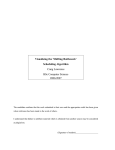Download Mid-Year Report as of 12-12-08
Transcript
Mid-Year Report 1 iLights Senior Design Project Jose D. Figueroa, Matthew C. Ryder, Nicholas Wittemen, and Chris Merola, Team Soules Abstract— People listen to music using iTunes more than any other media player currently available. Most media players have visualizers that can be placed on the screen to give the music more excitement. There problem with this is that visualizer software limits lighting effects simply to the screen and no where else. Light controllers exist, but for a high price and with no easy-touse interface. We propose a plug-in for iTunes that would give the user an easy-to-use interface that will control incandescent lights of various colors to bring the visualizer out of the screen and bring color and excitement to the user’s environment. I. INTRODUCTION problem our design solves is the constraint of light visualizations from iTunes in terms of actually realizing an external light visualization through the control of incandescent lights. This solution will provide an appropriate visual stimulation to complement the audio experience of iTunes users. Users would like to be able to bring life to their music and do away with the isolation of the computer screen. While devices already exist to dim lights in response to music, they do not give the user a GUI (Graphical User Interface) from which they can control what audible frequency ranges the lights will interact with. iLights allows users the ability to plug in four incandescent lights and have them interact with the beat of the song playing in real time. Users can select which range of the audible spectrum they want each channel to react to through the iTunes plug in; the user will see a display of the frequency spectrum output of the song to allow band selection to be done straightforwardly. This will supply the user with four selectable ranges for four different lights to react in response to treble, bass, mid-range, or any other variation of the audible spectrum. HE T A. Requirement Specifications 1. Deliver up to 500W X 4 output channels, 2000W max. 2. Go from off to fully illuminated and back off again in under 75ms (800bpm). Manuscript received November 20, 2008. This work was supported in part by SDP 2009. Jose D. Figueroa is a senior in Electrical Engineering at UMASS Amherst Nicholas Wittemen is a senior in Electrical Engineering at UMASS Amherst Chris Merola is a senior in Electrical Engineering at UMASS Amherst Matthew C. Ryder is a senior in Electrical Engineering at UMASS Amherst 3. Lights to be fully illuminated within 80ms of audio input (Human sync detection range). 4. iTunes plug-in that allows users to select frequency band between 20 - 20,000Hz as trigger for each channel. 5. USB 1.0 link to Arduino microcontroller. 6. Documented source code + user manual II. DESIGN A. System Overview Our basic system design includes a computer with the iTunes program and our GUI along with a frequency analyzer. The software will communicate with our hardware via serial port communication from a USB 2.0 output on the computer to a USB 1.0 connection that will tie into the input of the iLights Hardware Box. The hardware box contains the microcontroller and electrical circuit components needed to use the frequency information provided by our GUI to obtain control of the four channels where the incandescent lights will be connected. Each channel will be capable of safely handling 500W. Addition shielding will be included in order to minimize the hazards of Electromagnetic Interference (EMI) resulting from the power signals. Mid-Year Report 2 B. Block Diagram User Input Computer Open GL Interface iTunes Frequency Extraction C++ Power Source Arduino Serial input buffer Check for data and read data Light Light Light Light Dimming Control Library, call a *.dll file, which can access frequency data through iTunes provided variables. iTunes does a FFT (Fast Fourier Transform) of the audio being played and makes available the power contained in 256 samples spaced linearly from 20 Hz to 20kHz. The data is provided is of type Uint8 giving 256 steps of resolution. OpenGL is used to display this data graphically, specifically a package named freeglut. We have chosen this package because is built to be both easy to implement and extremely portable; although we are developing in Windows we would like to be able to port our software to OSX. At this time we are displaying a level bar for each of the 256 available bands. Our code controls the bar height using a log scale in order to compare power in the same way as the human ear. As of now our software is able to communicate with iTunes, extract the frequency spectrum of the audio being played, and display this information graphically. The next step will be to implement a user interface. We will use handlers available in the freeglut package to do this. We have already experimented with input using this package and have determined that it will be able to handle the input our project requires. Triac Triac Triac Triac Fig. 1. System block diagram. Two large boxes encompass the portions working from the Arduino platform and from the PC. C. System Specification iTunes interface Our software must be able to communicate with iTunes in order to control lights based on the music being played. The software will also allow the user to select frequency ranges that will control each iLights electrical outlet. From data extracted with iTunes we will determine the power contained in a number of user selected frequency bands and use this to set the amplitude of the connected lights. Due to the physical properties of triacs, the fastest we can adjust the power sent to our lights is 120 times per second. This is the rate at which we will retrieve audio spectrum information form iTunes. This data will be updated and packaged to be sent via USB to our hardware continuously. As of this time we are able to extract frequency data from iTunes and display a spectrograph of the audio file being played. To extract frequency data we use the software development kit released by apple for visualization development. Using this we implement a Dynamic Link Serial Port Communication Link The link from the pc to the microcontroller that triggers the switching circuitry is compromised of 2 parts: C++ code which translates and transmits the extracted frequency data over the serial port; and an Arduino prototyping board with an Atmega168 that has been programmed to read the serial port data and interpret it into control instructions for triggering the triac circuits. The extracted frequency data will consist of 256 samples of the audible frequency range, and the user will specify 4 different spans of this frequency band they want their 4 lights to react to. The power over each of these frequency bands will provide the output control signal to be written to the serial port. To send these 4 signals simultaneously we will have to store them in an array and write the whole array to the serial port. This writing must occur at the same rate we set the Arduino board to operate at. Currently a baud rate of 19200 has been used consistently in our code. The microcontroller will then read the serial port and take the 4 individual elements of this array and translate the power over each frequency band into the appropriate phase control. Phase control works by turning on a fraction of each half wave; current through the load is proportional to the area under this portion of the sine wave. The Arduino determines when to trigger each triac and turn on this signal to provide phase control. This is done using the Arduino to detect zerocrossings which, since our ac power is mostly constant at Mid-Year Report 120Hz, will remain at approximately 1/120 seconds apart. This data will continuously be collected, allowing us to accurately switch on during the desired phase of the pulse, resulting in real-time phase control of the 4 incandescent lights. Light Control Circuitry The idea for controlling the light is to use a type of phase control. AC mains are rated at 120VAC at 60Hz. The amount of power provided to an incandescent light is essentially the area under the sinusoidal wave. If we are able to supply half the amount of power during every half-cycle then we essentially deliver half the power to the incandescent bulb which in return creates an affect of the incandescent light bulb being half as bright as usual. The use of a power triac is ideal for this. This is demonstrated in the figure below: Fig. 2. Graph of AC mains (RED) and supply of half of each half-cycle to the load (GREEN). Graph also represents triggering the triac on to dim the bulb at half of its full brightness (GREEN). The power triac is a device of the Thrysistor family which allows for switching of AC loads either resistive or inductive. The triac of choice is the BTA20-700CW snubberless triac from ST Microelectronics. The way the device works is by attaching the mains (120VAC) to pins A1 and A2. Pin G is a gate triggering pin which will activate the triac and allow current to flow through pins A2 and A1. The uniqueness of this device is its capability to block the current flow when the AC main voltage crosses zero. In order to allow currently flow the triac would need to be triggered once again. This property makes the device ideal for phase control of our lights. The triac is capable of withstanding 700V at 20 A which makes it completely capable of meeting our design requirements of 500W x 4. The second device needed to control the lights and interface with the microcontroller is a Triac Driver IC. This device is needed to isolate the sensitive microcontroller from the main lines that the power triac will be controlling. The device of interest is the FOD4218 newly designed by FAIRCHILD Semiconductors. This device is a random phase opto-isolated triac driver. Within the device there is an infrared light emitting diode which optically triggers an infrared sensitive triac. When this triac is triggered it will supply an output 3 trigger for the power triac therefore safely preventing any current from entering the microcontroller. Fig. 3. Basic structure of design concept for controlling a single incandescent light bulb or channel. Image provided by Fairchild Semiconductors The last major component of the light control circuitry is a zero cross detection circuit. This is needed in our design so that the system knows when the AC mains cross zero and therefore calculate a delay after the zero crossing to switch the power triac to its on state. This has been achieved easily with the use of an Atmega168. Atmel released a bulletin that the Atmega can be directly connected to the mains with 1Meg resistors at the input pins and due to the internal clamping diodes it was possible to achieve a zero cross detection circuit. The clamping diodes keep the input pins between Vcc + 0.5V and Vg – 0.5V. The 1Meg resistors limit the current 1mA max up to 1000V. This will allow us to know when the main crosses zero in order to set-up a delay trigger to the power triac. With this trigger to the power triac we can control where we trigger the power triac on within the half cycle. This, in return, gives us the ability to control the power to the incandescent light bulb and vary its brightness with the microcontroller. Both triacs in our design are snubberless meaning that there is no need for external components such as RC or RLC circuits to suppress transient spikes from the mains or the load. Our load is also purely resistive so that also eliminated the need of such circuitry. Electromagnetic Interference and Compatibility Since our project involves switching large amounts of AC current very quickly, electromagnetic interference (EMI) is an issue we are going to have to address. When large amounts of current are switched in close proximity to other circuits, they can induce a current in those circuits which will have a detrimental effect on performance. For example, in our circuit we are counting zero-crossings of the main AC line and also triggering the triacs with digital circuitry. The EM fields produced by the triac output lines could induce a current in the zero-cross circuit and produce a fake zero crossing or it could induce a current in the triac triggering circuit and trigger the triac when it is not supposed to be triggered. The Federal Communications Commission (FCC) has passed many Mid-Year Report restrictions on the amount of EMI consumer electronics are allowed to produce. A product which produces too much EMI will degrade the performance of other products/appliances nearby. To help reduce EMI in our circuit, we are going to first use capacitors to couple the ac lines with the ground lines. This will prevent sharp and sudden voltage spikes due to ground noise. Y-type capacitors are ideal for this because they are double insulated and designed for this purpose. X-type capacitors can be used between ac line and neutral together to further reduce interference. We will also arrange our circuit in such a way that minimizes EMI. The best way to do this is to have small loops on the PCB and to have lines carrying large amounts of current going in opposite directions. When two lines with equal current go in opposite directions, they each produce an EM field equal but opposite to the other. This will dramatically reduce our emissions. Large loops in a path amplify the ability of that path to conduct and radiate noise. Prevention of this type of noise will be done by keeping highcurrent loops far away from low-current loops and by keeping loops as small as possible. D. Design Alternative We have considered other alternatives in the case that something may not work as originally planned. Reasons we would need alternatives would be if iTunes SDK is inadequate for allowing frequency extraction. In this case we have considered the possibility of using alternative media players such as Winamp open-source or VLC media player. The second design alternative would be replacing the triac if it is found not to be the best way for controlling the lights. Silicon-controlled rectifier (SCR) could be another solution for better switching and control of lights. We could also choose Resistive Dimming by rectifying AC to DC and using different lights. However this could limit the amount of power we would be able to switch due to heat emission. 4 software compatible for both Mac and PC operating systems. Nicholas Wittemen has been progressively developing a serial communications link with C++ and the processing language to make data transfer possible between the iTunes software plug-in and the Arduino microcontroller that will drive the triggers for the triacs in order to control the lights appropriately. He is also the team coordinator. Jose D. Figueroa has been assigned to designing the triac circuit which will handle 4 x 500W, 2000W total, and taking all safety precautions when interfacing with a live AC source. He is also the webmaster who is responsible for updating and maintaining Teams Soules’ website. Matthew C. Ryder as been doing research on EMI (Electromagnetic Interference) so that our product not only functions properly within its contained environment but that it also meets all FCC regulations and safely interfaces with normal consumer electronics in a home with out effecting or causing damage to other products. V. SUMMARY AND CONCLUSIONS A. System Overview Please check with your editor on whether to submit your manuscript as hard copy or electronically for review. References B. System Overview Please check with your editor on whether to submit your manuscript as hard copy or electronically for review. ACKNOWLEDGMENT Team iLights would like to extend our thanks to professor T. Baird Soules for his guidance and the insight he contributed to our research. We would also like to thank Paul Badger, owner of ModernDevice.com, for his timely and considerate assistance for handling our requests for assistance. III. MDR PROTOTYPE IMPLEMENTATION A. System Overview Please check with your editor on whether to submit your manuscript as hard copy or electronically for review REFERENCES [1] [2] [3] [4] IV. PROJECT MANAGEMENT [5] A. System Overview Our team as split the project up into four main areas: Chris Merola is responsible for designing the easy-to-use GUI along with the iTunes plug-in with iTunes SDK to extract frequency information. He is also charged with making the [6] [7] [8] Shreiner, Dave, Mason Woo, and Jackie Neider. OpenGL Programming Guide : The Official Guide to Learning OpenGL, Version 2. New York: Addison Wesley Professional, 2005. "The World Famous Index of Arduino & Freeduino Knowledge." <http://www.freeduino.org/>. "Arduino Home." <http://www.arduino.cc/>. Curcio, Igor D., and Miikka Lundan. Human Perception of Lip Synchronization in Mobile Environment. Tech.No. Research Center, Nokia Corporation. IEEE Xplore, 2007. 1-7. Benhard, Ryan G. "EMI Considerations in Selecting AC/DC Switching Power Supplies." Power Supplies. Oct.-Nov. 2005. Elpac Electronics, Inc. 3 Dec. 2008 <http://www.devicelink.com/mem/archive/05/10/007.html>. Fairchild Semiconductors: Datasheet: FOD410, FOD4108, FOD4116, FOD4118 Rev. 1.1.4 Fairchild Semiconductors: Datasheet: Application Note AN-3004 ST Microelectronics: Datasheet: BTA20 BW/CW




